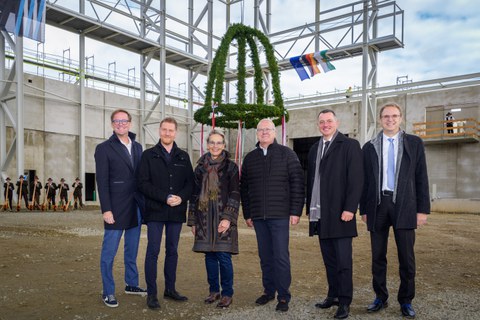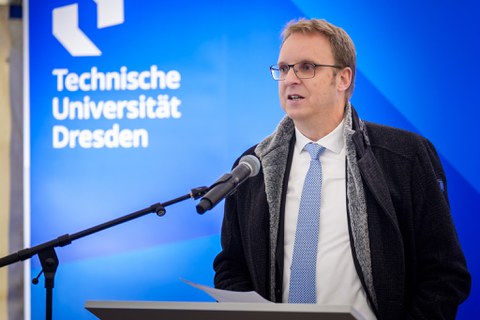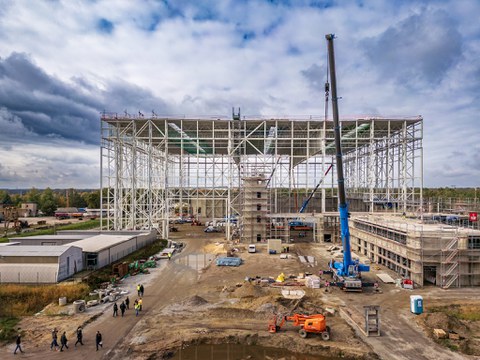16.10.2025
Richtfest für das Smart Mobility Lab
Am 15. Oktober 2025 hat die TU Dresden in Hoyerswerda-Schwarzkollm das Richtfest für das Smart Mobility Lab (SML) gefeiert. Vor Ort waren u. a. Sachsens Ministerpräsident Michael Kretschmer und TUD-Rektorin Prof. Ursula M. Staudinger, die die Bedeutung des Vorhabens für Innovation und Strukturwandel in der Lausitz unterstrichen. Die zentrale Fahr- und Flugversuchshalle des künftigen Forschungscampus steht im Rohbau; bis Ende 2026 folgt der Ausbau, der Forschungsbetrieb soll 2027 starten. Insgesamt sind Investitionen von über 86 Mio. Euro vorgesehen, verbunden mit der Schaffung von mehr als 300 Arbeitsplätzen.
Als Sprecher des Projekts ordnete Prof. Günther Prokop in seiner Ansprache die nächsten Schritte ein und skizzierte, welche Forschungsfelder das SML künftig bündelt. Er steht mit fünf weiteren Principal Investigators für die interdisziplinäre Ausrichtung des Campus – von Straßen- und Luftverkehr über Robotik bis hin zu Software- und Netzwerksystemen. Die enge Zusammenarbeit mehrerer Professuren – darunter Kraftfahrzeugtechnik, Luftverkehrstechnik und Logistik, Softwaretechnologie, Vernetzte Systemmodellierung, Landtechnik und Mobilitätssystemplanung – bildet die Basis, um automatisierten und vernetzten Verkehr gemeinsam zu erforschen und Ergebnisse schnell in die Anwendung zu bringen.
Herzstück des SML sind großskalige, kombinierbare Versuchsumgebungen: eine rund 100×100 m große, stützenfreie Testhalle mit hoher lichter Höhe, Außenflächen inklusive Fahr- und Landebereichen sowie spezialisierte Labore (u. a. Klima- und EMV-Infrastruktur). Ein besonderer Fokus liegt auf einem Verbund aus Simulatoren – darunter der Dresden Driving Simulator–, der gemeinsam mit realen Erprobungen eine szenariobasierte Entwicklung und Absicherung ermöglicht. Damit wird das SML zugleich die neue Heimat für den Dresden Driving Simulator und weitere Simulatoren, die in ein cyber-physisches Testumfeld integriert werden.
Der Lehrstuhl Kraftfahrzeugtechnik bringt hierfür seine ausgewiesene Stärke in modell-, daten- und szenariobasierten Simulations- und Absicherungsverfahren ein – von der Fahrdynamik- und Komfortsimulation über HMI/HF-Untersuchungen bis zur Validierung von ADAS/AD-Funktionen. In Kombination mit den Prüfständen und digitalen Entwicklungsprozessen des Fahrzeugtechnischen Versuchszentrums (FVZ) der TU Dresden entstehen so einmalige Forschungsmöglichkeiten: Simulation und hochpräzise Experimentik greifen ineinander, Ergebnisse lassen sich skalierbar von HiL/SiL-Setups über den Simulator bis in den Realversuch übertragen
Die breite Beteiligung aus Wissenschaft, Politik und Region beim Richtfest – mit Beiträgen des Ministerpräsidenten, der Rektorin und Vertretern der Stadt und des Landkreises sowie der Projektleitung – verdeutlicht den gemeinsamen Anspruch: In Schwarzkollm entsteht eine europaweit ausgerichtete Forschungsplattform, auf der die TU Dresden mit ihren Partnern die Mobilität der Zukunft entwickelt, erprobt und in die Praxis überführt.



